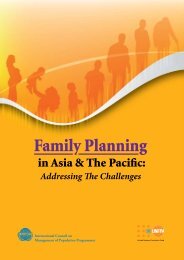Inter-lInkages between PoPulatIon DynamIcs anD DeveloPment In ...
Inter-lInkages between PoPulatIon DynamIcs anD DeveloPment In ...
Inter-lInkages between PoPulatIon DynamIcs anD DeveloPment In ...
Create successful ePaper yourself
Turn your PDF publications into a flip-book with our unique Google optimized e-Paper software.
The Gross Domestic Product (GDP) growth rate continued to be strong. It shows a slight increase from 6.0%per annum in Fiscal Year (FY) 2005 to about 6.5-6.6% during FY 2006-2007. For FY 2007, the industrialsector grew at 10.6% per annum while the service sector grew at 6.4% per annum. The agriculture sectorshows marginal growth of 3.2%.Relevant Policies related to <strong><strong>In</strong>ter</strong>-linkages <strong>between</strong> Population Dynamics and DevelopmentA range of policies, consisting of core national policies and sector-specific strategies, were formulated byBangladesh to guide the management of national development. The policies are in line with the country’sPRSP 2. The key policies and sector-specific strategies are as follows:Bangladesh Population Policy 2004Bangladesh Population Policy 2004 was formulated to supersede the 1976 Population Policy Outline. Itacknowledges the importance of balance <strong>between</strong> population and development for the socio-economicdevelopment of its citizens.The objectives of this Policy are to improve: (i) the status of FP, maternaland child health (MCH), including RH services; and (ii) the livingstandard of the people of Bangladesh.The challenges underscored in the Policy pertain to the following themes:1. TFR and NRR;2. Availability and access to RH services, including FP;3. <strong>In</strong>fant mortality rate (IMR);4. MMR;5. Malnutrition;6. Early childhood development;7. Gender disparity, equity and empowerment of women;8. Reproductive tract infections (RTIs)/sexually transmitted infections(STIs) and HIV/AIDS;9. Disadvantaged populations;10. Rural to urban migration;11. Environmental sustainability, emphasising on safe drinking water;12. Poverty alleviation and improved quality of life;13. Capacity of human resource; and14. Coordination among relevant ministries in strengthening POPDEV.National Health Policy 2008The National Health Policy (NHP) 2008 - revision is still on-going - isbuilt on from the NHP 2000 and 2006 as well as founded onBangladesh’s Constitution. The objectives of this Policy are to: (i)increase the availability of user-centred quality services for a definedEssential Service Package (ESP) delivery along with other health relatedservices; and (ii) develop a sustainable quality health service systemto meet the people’s need and to achieve the MDGs. Some of the keyareas identified for interventions are population planning, healtheducation and promotion, control of emerging threats, urban healthservices, and primary health care (PHC).Gender equality in health is underscored with the following interventions:• Ensure rights of women for a better physical and mental health atall stages of their life cycle;• Strengthen PHC for women with emphasis on reducing MMR andIMR;Population growth anddistribution influencedevelopment and in turn getinfluenced by it. As a multisectoralconcern, populationstabilisation requiresintegration of demographicfactors into the activities ofhealth, education, women’sdevelopment, urbanisation,housing, environment, povertyalleviation...Bangladesh Population Policy 2004The health sector seeks tosupport the creation of anenabling environment wherebythe people of Bangladesh havethe opportunity to reach andmaintain the highest attainablelevel of health. With a visionthat recognises health as afundamental human right, theneed to promote health isimperative for social justice.This vision derives from a valueframework that is based on thecore values of access equity,gender equality and ethicalconduct.NHP 20083














